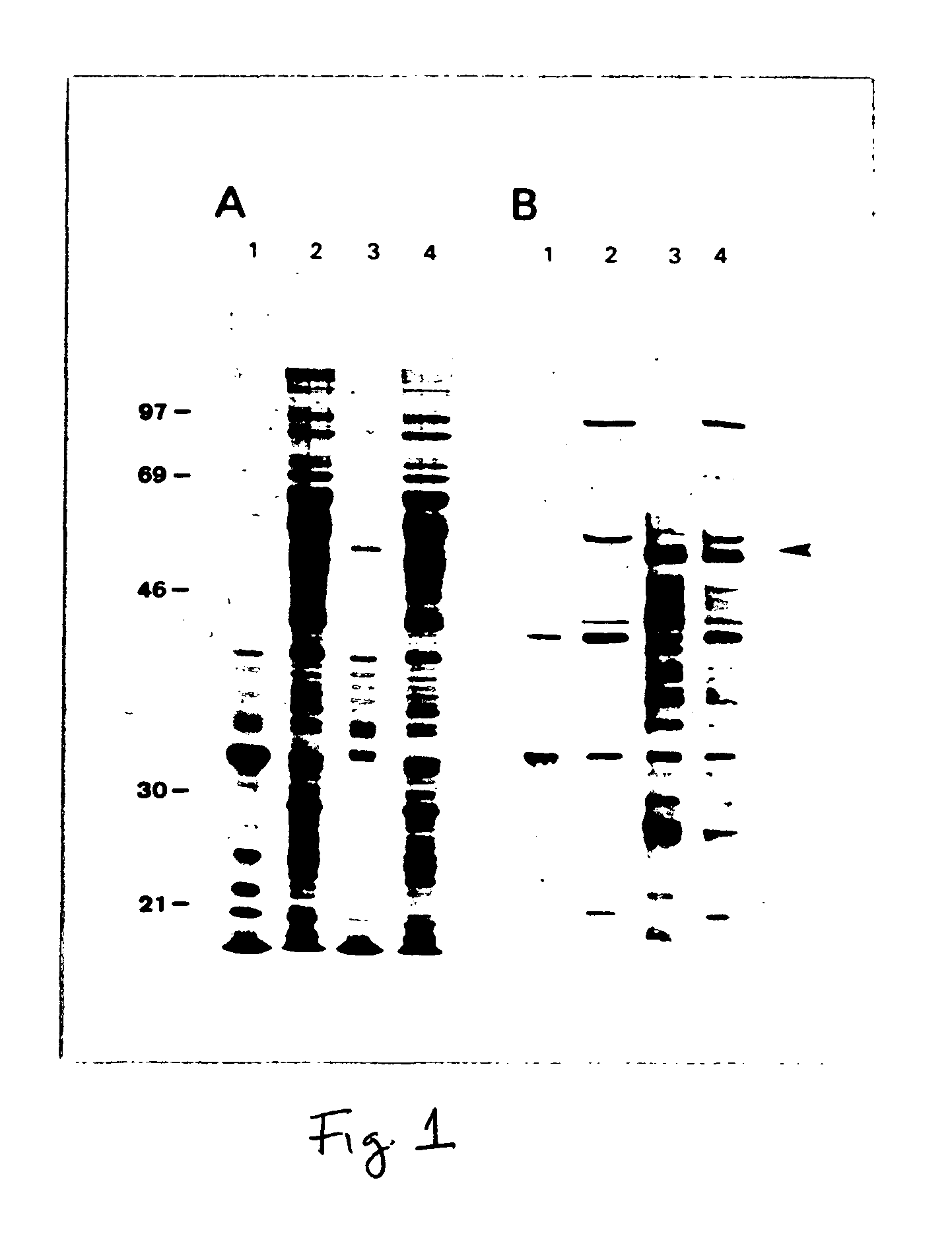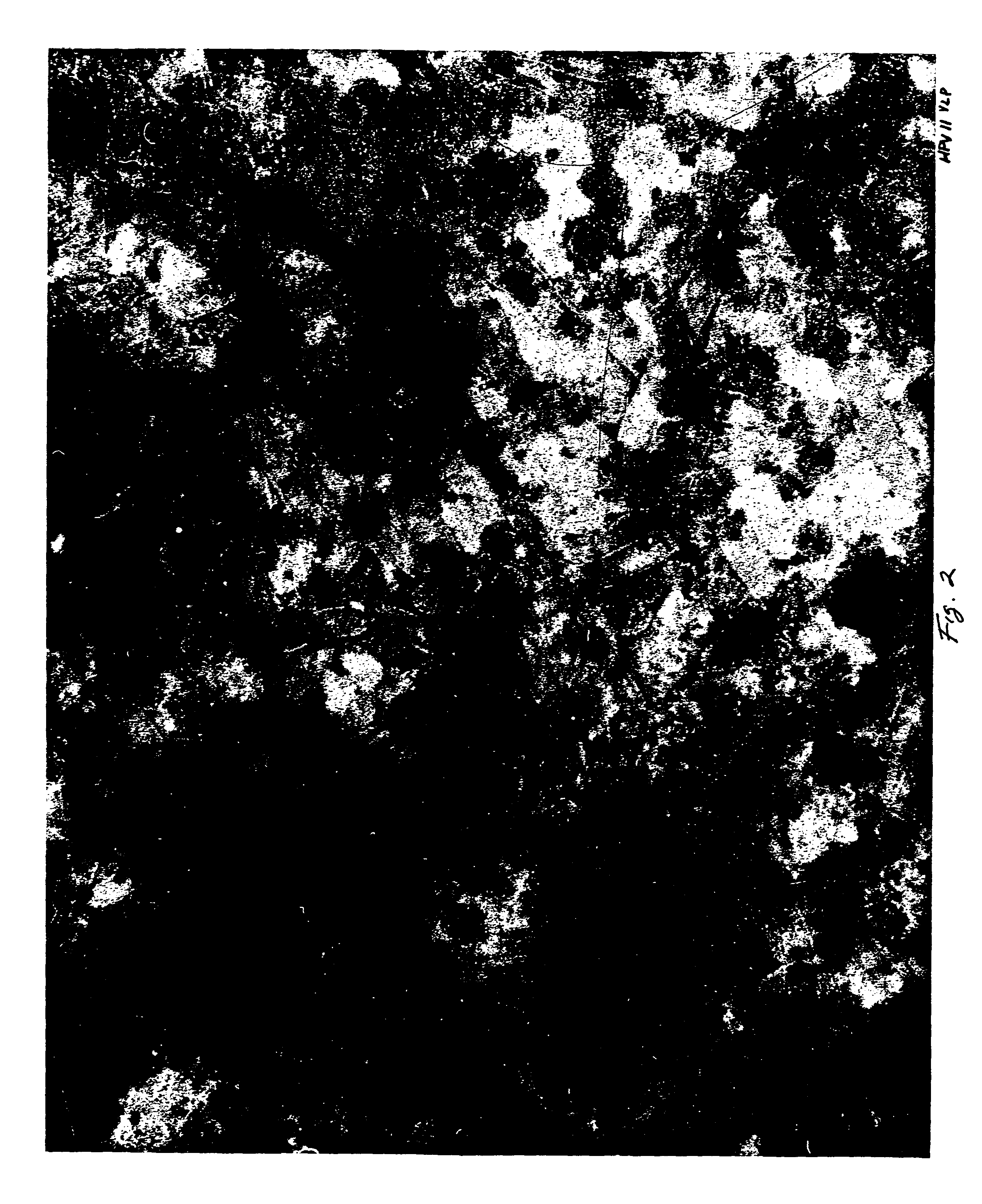Production of papillomavirus capsid protein and virus-like particles
a technology of capsid protein and papillomavirus, which is applied in the field of papillomavirus, can solve the problems of limiting the usefulness of the study, difficult to conduct the study, and high cost of the system
- Summary
- Abstract
- Description
- Claims
- Application Information
AI Technical Summary
Benefits of technology
Problems solved by technology
Method used
Image
Examples
example i
Materials and Methods
1. HPV-11 Viral DNA And pVL11L1 Baculovirus Transfer Vector Construction
[0039]HPV-11 genomic DNA was obtained from virus particles which were purified from experimentally induced athymic mouse xenografts as described by Rose et al., Expression of the full-length products of the HPV-6b and HPV-11 L2 open reading frames by recombinant baculovirus, and antigenic comparisons with HPV-11 whole virus particles, 1990, J. Gen. Virol., vol. 71, pp. 2725-2729, which disclosure is hereby incorporated by reference. The L1 coding sequence was cloned by PCR amplification of purified genomic DNA, using primers designed to introduce BglII and EcoRI restriction enzyme sites at the 5′ and 3′ ends, respectively. The forward and reverse primer sequences, respectively, were, 5′-CGC AGA TCT ATG TDG CCT AGC-3′ (SEQ. ID. NO. 1) and 5′-CAT ATG AAT TCC CAC AAC ACA CTG ACA CAC-3′(SEQ. ID. NO. 2). Restriction sites (underlined) were introduced proximal to the putative L1 start codon (bold ...
example ii
Expression And Immunologic Detection Of Recombinant HPV-11 L1 Protein In Sf-9 cells
[0048]SDS-PAGE analysis of total Sf-9 cell proteins from insect cells infected with the recombinant virus Ac11L1 demonstrated a novel 55 kD protein seen by Coomassie-blue staining in Ac11L1-infected cells (FIG. 1A, lane 3). With reference to FIGS. 1 (A and B), FIG. 1A shows Coomassie-stained SDS polyacrylamide gel of wild-type AcNPV and recombinant Ac11L1-infected Sf-9 cell lysates and FIG. 1B shows Western blot of wild-type AcNPV and recombinant Ac11L1-infected Sf-9 cell lysates probed with a rabbit polyclonal antiserum specific for the HPV L1 common epitope. Non-recombinant (lanes 1,2) and recombinant L1-infected (lanes 3,4) Sf-9 cell lysates were fractionated into insoluble (lanes 1,3) and soluble (lanes 2,4) fractions, and electrophoresed on 10% polyacrylamide gels. Molecular reference (Mr) markers are displayed at the left, and the arrow at the right indicates the approximate position of recombin...
example iii
Electron Microscopic Visualization of VLPs
[0049]Electron micrographs of negatively stained preparations of sucrose banded VLPs (FIGS. 2, 6, and 7) showed distinct VLPs. FIG. 2 shows HPV-11 capsid-like particles which were present at the 50-60% interface of the sucrose density gradient. FIG. 6 shows HPV type 6b (HPV-6b) capsid-like particles which resulted from the expression of the HPV-6b L1 coding sequence in the baculovirus system, and which were purified in exactly the same manner. FIG. 7 demonstrates that this method is also suitable for the production of HPV type 16 (HPV-16) VLPs, upon expression of the HPV-16 L1 coding sequence. Particle diameters determined by direct measurement of the VLPs in FIG. 2, were approximately 52 nm. This measurement is consistent with the diameter of isolated papillomavirus virions as described by Klug et al., Structure of viruses of the papilloma-polyoma type I: Human wart virus, 1965, J. Mol. Biol., vol. 11, pp. 403-423, which disclosure is hereb...
PUM
| Property | Measurement | Unit |
|---|---|---|
| Diameter | aaaaa | aaaaa |
| Volume | aaaaa | aaaaa |
| Size | aaaaa | aaaaa |
Abstract
Description
Claims
Application Information
 Login to View More
Login to View More - R&D
- Intellectual Property
- Life Sciences
- Materials
- Tech Scout
- Unparalleled Data Quality
- Higher Quality Content
- 60% Fewer Hallucinations
Browse by: Latest US Patents, China's latest patents, Technical Efficacy Thesaurus, Application Domain, Technology Topic, Popular Technical Reports.
© 2025 PatSnap. All rights reserved.Legal|Privacy policy|Modern Slavery Act Transparency Statement|Sitemap|About US| Contact US: help@patsnap.com



